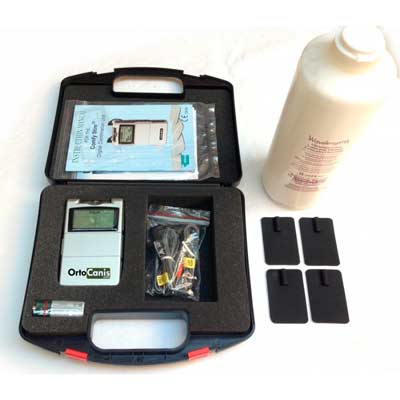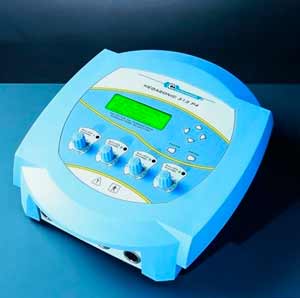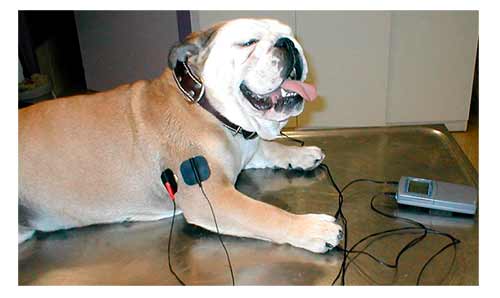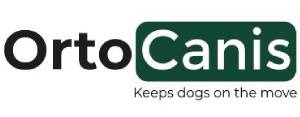Electrotherapy is one of the most commonly used techniques in human physiotherapy, however in the last 20 years it has also become extremely prominent in the veterinary world.
Electrotherapy began to be used on pets due to its success treating people and horses. It was initially used on racehorses, where care for the animals is determined by the amount of money generated by the races and the breeding.
Scientific literature offers various names by which to classify the types of electrotherapy:
- ES Electrical stimulation
- NMES Neuromuscular electrical stimulation
- EMS Electrical muscle stimulation
- FES Functional electrical stimulation
- TENS Transcutaneous electrical nerve stimulation
In order to reach our objective we must differentiate between two types of electrotherapy; antialgic electrotherapy and excitomotor electrotherapy or electrical stimulation.
Antalgic Electrotherapy
Antialgic electrotherapy is used on dogs to combat pain.
Electrotherapy is effective when treating musculoskeletal problems and when treating problems associated with internal medicine.
There are several types of antialgic currents but the best-known that has been used the most in recent years is the TENS current, which is the acronym in English for transcutaneous electrical nerve stimulation.
Antialgic electrotherapy produces different mechanisms of action. The conventional TENS mechanism of action blocks the pain stimulus at the medulla level so that it does not reach the central nervous system and get processed by the higher nervous centres. The endorphinic TENS, on the other hand, stimulates the release of endorphines. These are hormones produced by the dog’s own body which eliminate pain in a similar way to opioids.
Electrostimulation
Electrical stimulation involves applying an electric current to the dog’s muscles in order to stimulate the muscle and provoke muscle contractions. Electrical stimulation aims to generate electrical impulses that increase strength and muscle mass. It is used in rehabilitation to treat injuries that present muscle atrophy, whether this is due to lack of use or trauma related problems that have caused damage to muscle or the nervous system.
Diagnostic Electrotherapy
Using an electric current to make a diagnosis is another possibility that has arisen through electrotherapy. This science has a lot of potential but has been underused until now. In large veterinary hospitals electromyography is used to assess neurological changes, particularly in the peripheral nervous system. Using it and interpreting the results is a complicated process. It involves inserting needles connected to cables that serve as electrodes. It is a very invasive technique which is extremely uncomfortable for the dog.
Surface electromyography is an alternative, which has often been used in studies to determine when and to what extent certain muscles are contracting, whereas in research, development and innovation specific motor patterns are studied. However, it is not frequently used as a diagnostic tool.
The method commonly used in human physiotherapy involves determining the Strength-Duration curve in order to calculate the Chronaxie value. This value allows us to objectively assess the contractile capacity of a muscle and its level of denervation. As it is not invasive and easy to apply it can easily be used to evaluate the development of a peripheral nerve disorder in a very objective manner.
Veterinary Electrotherapy Equipment
There are different types of electrotherapy equipment. The market offers TENS equipment for home use, electrical stimulators that are also for home use and slightly more comprehensive, professional devices that are designed for use in clinics, hospitals or rehabilitation centers.
Equipment for use at home is very reasonably priced and offers fairly good benefits. It normally includes easy-to-use treatment programmes with default parameters.
You must take special care when applying the electrodes. We recommend using rubber electrodes and contact gel when treating dogs.
 Directions:
Directions:
Antialgic electrotherapy is mainly used to treat:
- Muscle aches
- Muscle fatigue
- Rehabilitation of sporting dogs
- Tendon pain
- Joint paint caused by contusions
- Osteoarthritis
- Post-surgical pain
Electrical stimulation is mainly used to treat:
- Muscle atrophy from disuse
- Neurogenic muscular atrophy
- Herniated disc atrophy
- Increasing strength in sporting dogs
https://www.ortocanis.com


